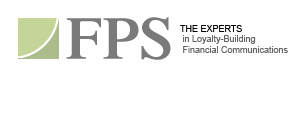Social Media for Commercial Bank Marketing:
A Waste of Time or a Valuable Tool?
Although it's been five years since social media burst onto the scene, wholesale bank marketers are, for the most part, still taking a "wait and see" attitude about using it as a tool.
According to some experts, banks may not want to fully integrate social media into their commercial marketing mix until they have a high-quality, customer-centric social media presence.
A waste of time?
But that might not be the only issue. According to a recent blog, "Why Social Media is a Waste of Time for Banks and Credit Unions," by The Financial Brand, an online publication for financial marketers, even if you are keeping your social media pipeline full and at least somewhat interactive, it still may be a "waste of time" as a marketing tool. That's because most financial institutions participating in social media have a very weak following. They post new information less than once a month, and when they do, rarely have comments posted by readers, according to the blog.
This lack of reader engagement, the blog says, is due to a variety of factors:
- Most Internet users are "oversubscribed" and have precious little time to read the bank's content.
- The bank's Web site faces stiff competition from other sites for viewer attention.
- The bank site fails to deliver compelling, consultative content.
Blocked access to social media sites
Another reason limiting the effectiveness of social media compared to other online commercial bank marketing channels: access issues. Some 71% of businesses actively block access to social networking sites on company computers, according to an August 2011 survey by international law firm Proskauer Rose LLP. Reasons given for blocking access to social media sites included reputational risk and concerns about security and legality. In addition, companies fear that if granted access from their work computers, employees will spend significant chunks of time on social media sites and will become less productive on the job.
The long-term view
With both corporations and their banks placing severe limitations on social media participation, it's no surprise that few banks have been able to leverage this medium in any measurable way. In contrast, however, other research shows that banks that do not have an active social media presence may suffer long-term damage to their reputation and brand.
"Unlike most technology risks, a bank cannot avoid the risks presented ... simply by not engaging in social media," said Tom Hinkel, Director of Compliance for the hosted IT service provider Safe Systems, in a recent article in American Banker.
Even if a bank decides against having a presence on LinkedIn, Facebook, Google+ or Twitter, for example, there's nothing to prevent someone from pretending to be a bank representative or otherwise communicating on these sites information that reflects negatively on the bank, Hinkel noted.
A case in point, according to the American Banker story, is a fake Bank of America account recently posted on Google+. The site used the bank's official logo, actual address and phone number, and links to the real B of A corporate Web site to create the impression that B of A was the actual sponsor of the page, reported Steven Ramirez, CEO of Beyond the Arc, a financial institution consulting firm. The page stayed up for more than a week, featuring a number of reputation-damaging postings. One posting falsely claimed that B of A was scheduling parties in foreclosed homes, while another stated that the bank was threatening to seize the accounts of Occupy Wall Street protesters, a claim that also proved to be unfounded.
One way that a bank can try to prevent spoofing, or make it more difficult, is to establish a presence quickly on new social media platforms, Ramirez advised. Banks need to establish a counter narrative before the negative commentary dominates the bank's presence in social media. By doing so, a bank establishes its "authentic voice," which helps to disarm the credibility of spoofing sites.
While Bank of America did have its own Google+ page up at the time of the attack, because the official site had almost no content on it, it left the bank open to the spoofing incident, Ramirez suggested.
Connecting with business customers
Despite the challenges, some major banks are looking to social media as a way to stay more connected with their business customers.
Wells Fargo wants to harness the collective wisdom of the thousands of corporate customers who use its Commercial Electronic Office (CEO) wholesale banking platform, noted Jeff Tinker, Senior Vice President and National Sales Manager in Wells Fargo's Treasury Management business group, in an article in the December/January 2012 edition of Treasury & Risk. This strategy benefits both the bank and its corporate customers. The bank obtains more customer input, while customers gain access to a broad array of peers with whom to converse and consult.
American Express has also established several American Express Forums made up of closed communities. One is the small business Open Forum, which consists of select American Express officers and small business clients (http://openforum.com). A second forum targets credit card customers (http://creditcardforum.com/american-express/). The intent of the American Express sites is similar to that of Wells Fargo. Customers use the social media sites to communicate both with American Express and their peers.
Bank of America, in response to the malicious spoofing episode noted earlier, has implemented an open social media channel developed for small businesses (http://smallbusinessonlinecommunity.bankofamerica.com/index.jspa).The bank is using the site to gather intelligence about what online business tools business owners find most valuable. The site also cultivates discussion regarding new services yet to be implemented. Many of the features B of A clients found to be most valuable were time-savers, such as receiving e-mail alerts and getting responses to direct inquiries via text messages.
Internal social media use
Banks are also increasing their internal use of social media. This strategy is popular among banks looking to eliminate the redundancies and disconnects often inherent in having multiple locations. For example, Wells Fargo is developing an internal social media collaboration strategy.
With 280,000 employees nationwide, Wells Fargo's initial focus is on customer support centers. "With our service and support operations located all over our geographic footprint, we need to be able to collaborate virtually. We are evaluating current business processes and how we can use social tools to enhance collaboration," said Kelli Carlson-Jagersma, who is heading up the Wells Fargo initiative, in an article in the November 11, 2011 edition of Informationweek.com. The bank's goal is not to replace current customer support practices but rather to make them more connected and more efficient, she said.
Whether or not internal social networking tools will reduce service times or e-mail volume remains to be seen, Carlson-Jagersma said. "But what I do hear from everyone is, 'Oh my gosh, it's so nice to put a face to a name.' We've made this huge company feel a little bit smaller. That has been the immediate benefit."
. . .
FPS regularly works with financial services companies to maximize the impact of their client communications. We provide content development, e-mail delivery and data tracking and analysis services. To find out how we can help you develop effective strategies for communicating with corporate financial executives, contact FPS President Vince DiPaolo at 847-501-4120 x3 or [email protected].
If you are not already a MarketScope subscriber, please request your own free monthly edition.
|





 Subscribe to MarketScope RSS Feeds
Subscribe to MarketScope RSS Feeds Join the B2B Financial Services
Join the B2B Financial Services